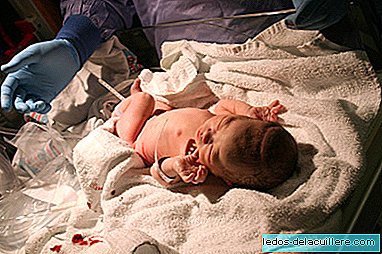
Recently we have talked about a series of prenatal risk factors that are of great importance in the optimal development of the fetus. Well, there are also some perinatal risk factors (that is, during childbirth and delivery) that it is also important to know.
Among these factors we find prematurity and low birth weight of the baby, respiratory problems, perinatal asphyxia, metabolic problems or hyperbilirubinemia.
Let's look in more detail at each of these factors that can compromise the proper motor, cognitive, communicative, linguistic and social development of the newborn.
- Prematurity: To determine if a baby is premature or not, gestation times must be differentiated due to the different repercussions they may have for the newborn. Thus, term delivery is understood as the one that occurs between 37 and 42 weeks of gestation; Premature birth would be the one born before 37 weeks and post-mature delivery, the one born with more than 42 weeks gestation.
- Low birth weight: In the same way that you have to check the gestation times to see the possible effects on the development of the baby, its weight must also be taken into account. In this way, we differentiate children with low weight (when born with a weight between 1,500 and 2,500 grams), very low weight (the baby is born with a weight between 1,000 and 1,500 grams) and extremely low (a lower weight to 1,000 grams).
Among the factors that are observed as possible causes of prematurity of the baby and low birth weight we find multiple pregnancies, some type of maternal infection during pregnancy, genetic factors, consumption of drugs and tobacco or nutrition problems by Mother.
- Respiratory problems: the most important problem of the premature child is the Respiratory Distress Syndrome, which consists of respiratory failure due to the lack of a lipoprotein (which begins to be produced in sufficient quantities from week 34) that covers the surface of the pulmonary alveoli and prevents them from collapsing during normal breathing. After receiving treatment for this respiratory failure, many children develop a chronic disease called bronchopulmonary dysplasia, being more likely to suffer from those children who are more than 30 days with assisted breathing or weighing less than 1,250 grams (in addition, they usually have some type of developmental delay or language problems as they grow). On the other hand, premature babies may also suffer from apnea: an irregular respiratory pattern that is characterized by prolonged pauses because the Central Nervous System is still immature or has some type of damage.
- Perinatal asphyxia: It is due to a decrease in the amount of oxygen that is produced and sent to the baby's cerebral blood flow. It is evidenced by giving a low score on the APGAR test, showing the baby some irritability, exaggerated responses or loss of sensitivity and low muscle tone. Persistent and severe seizures and even coma may also appear. The causes can be several, among which the problems with the placenta or umbilical cord, difficult delivery or too large baby should be mentioned. Those children with such a problem can present from a certain general hypotonia to evolutionary retardation and cerebral palsy.
- Metabolic problems: Children with low birth weight or prematurity are those who are more susceptible to problems of this type. Deficiencies can occur in essential products for brain metabolism (such as glucose) or insufficient minerals such as calcium, potassium, sodium, phosphorus, iron and magnesium. However, there are screening programs to detect these possible metabolic disorders, such as the heel test.
- Hyperbilirubinemia: Most babies develop some degree of jaundice, which is due to a high amount of bilirubin (yellow pigment that occurs when the red blood cells break down). In the case of premature babies and low weight babies with elevated bilirubin levels there is an increased risk of cerebral palsy and sensorineural hearing loss.
These are the perinatal risk factors most important that we can find, but there is still one to consider, and that of the environment in the neonatal intensive care unit. We will talk more deeply about this, as it is a vitally important factor that is sometimes overlooked.












